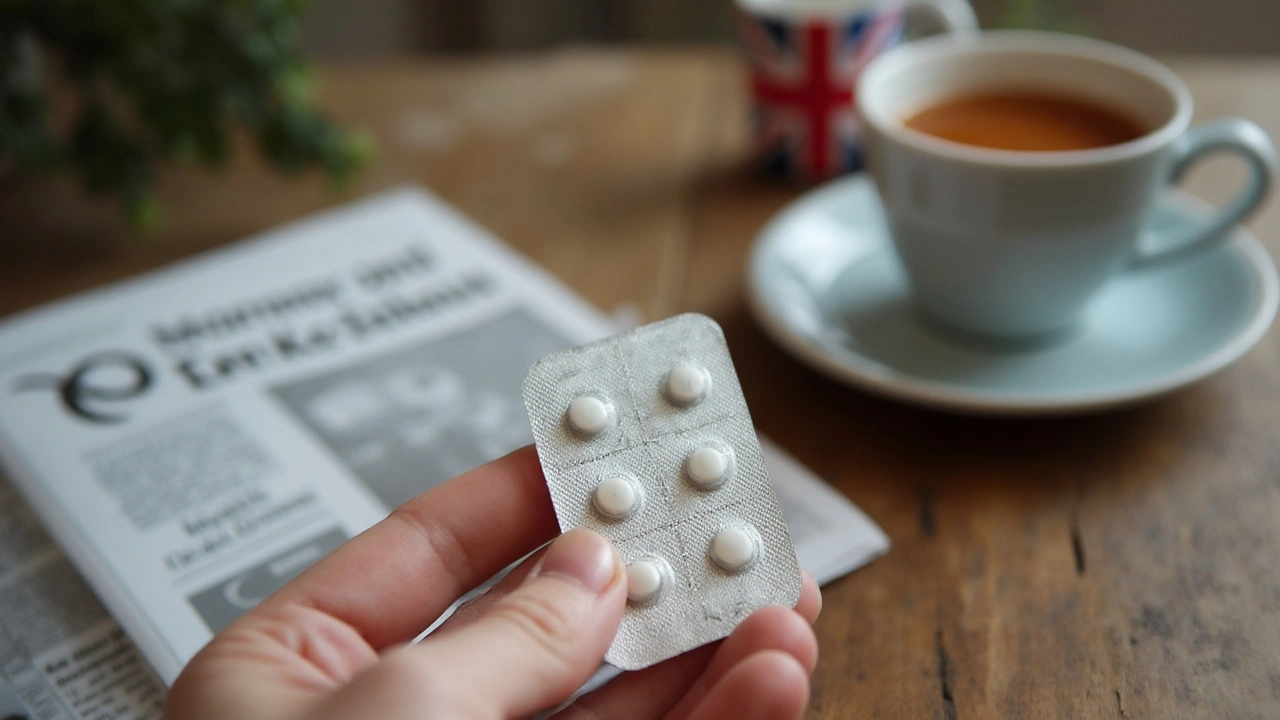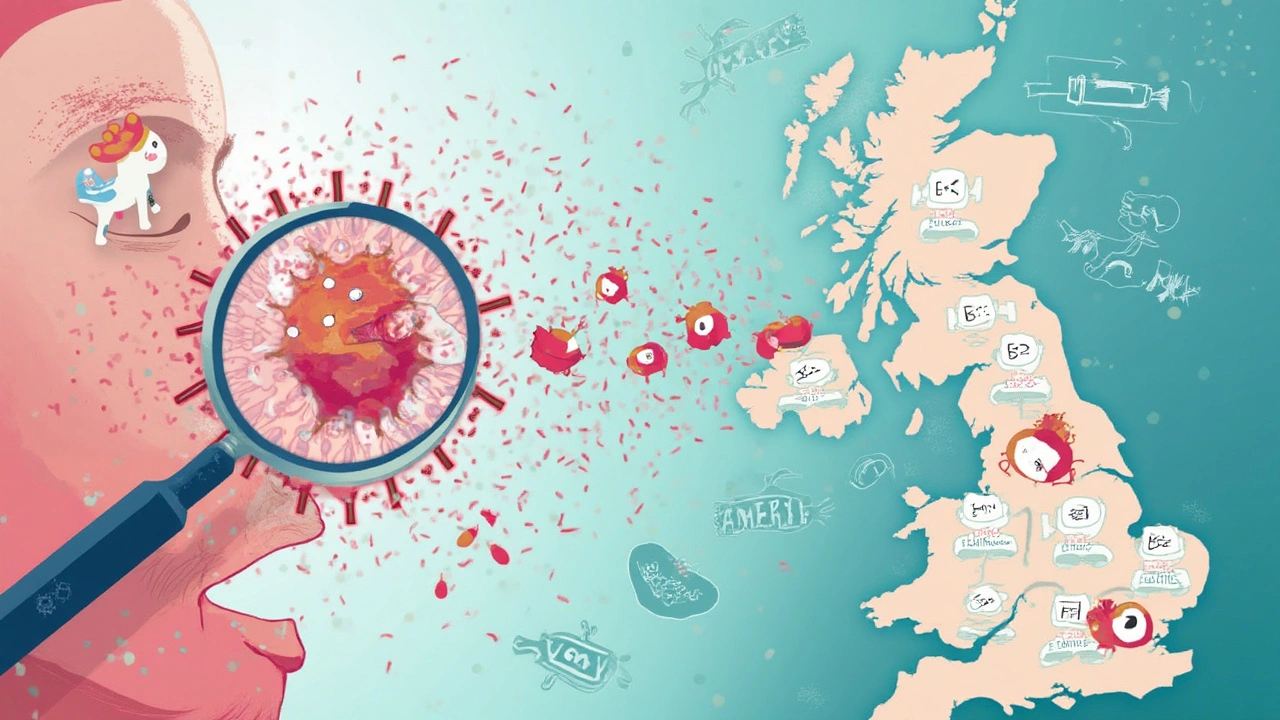The cold, hard truth? Kids these days—my own included—catch every cough and sniffle going round at school. The word “antibiotic” comes up more times in our house than “bedtime.” Now, erythromycin isn’t as flashy or hyped as those catchy new meds plastered on late-night TV, but this tried-and-true medicine has been quietly helping folks stay healthy for over half a century. Let’s get under the surface and talk about why erythromycin is still around, what makes it tick, and the stuff no one bothers to mention until you’re actually handed that little white bottle at the pharmacy. Because trust me, whether you’re worried about your own sore throat or your kid’s maddening cough, you want the inside scoop.
What is Erythromycin, and How Does It Actually Work?
Okay, let’s cut the fluff: erythromycin is an antibiotic—meaning it fights bacteria, not viruses. It doesn’t kill bacteria like a sledgehammer; instead, it stops them from making the proteins they need to grow. That slows the whole infection down so your immune system can clean things up. Erythromycin comes from a natural soil bacteria, which sounds wild, but it’s true. Scientists discovered it back in 1952 in the Philippines, and it quickly made its way into hospitals worldwide. Here’s what’s cool: unlike penicillin, erythromycin can often step in when you’re allergic—super handy if your body treats penicillin like some sort of invader from outer space.
This antibiotic covers a pretty wide range. We’re talking everything from chest infections (like pneumonia or whooping cough) to skin nasties (impetigo, boils), eye infections, ear infections, and even stuff like “atypical” pneumonia, which isn’t always picked up by standard antibiotics. One fun fact: in Australia, erythromycin is commonly used in newborns to prevent a nasty eye infection caused by certain bacteria picked up during birth.
It’s also on the World Health Organization’s List of Essential Medicines, which basically means the world agrees we can’t do without it. But, and this is big, lots of bacteria are getting wise to old antibiotics. Resistance is a real problem, and it means we can’t throw erythromycin at every sore throat, even if it’s easier than explaining to your teenager why they don’t get a ‘magic pill’ for their cold.
| Fact | Detail |
|---|---|
| Year discovered | 1952 |
| Made from | Streptomyces erythreus (soil bacteria) |
| Common uses | Respiratory, skin, soft tissue, eye, and certain sexually transmitted infections |
| Penicillin substitute? | Often, yes—good option for allergies |
| Formulations | Pills, liquid, topical ointment, IV |
One thing that stands out: erythromycin doesn’t just come in pill form. It’s available as syrup (Ronan insists the taste isn’t as terrible as some), ointments, and even eye drops—so it’s surprisingly versatile. The trick is, it’s not absorbed brilliantly if you take it with food. Doctors usually recommend you swallow it on an empty stomach. Easier said than done when your kid’s already grumbling about feeling rubbish. Bottom line: erythromycin takes about an hour to kick in, but you’ll need a few doses for results. Always finish the full course. I know, you’ve heard it a million times, but it matters—because bacteria are sneaky and can come roaring back if you bail out too early.

Erythromycin Uses: When Doctors Reach for This Antibiotic
Most of us think “infection = pills = done.” But medicine is rarely that simple. Erythromycin earns its keep by being a workhorse against a bunch of bacteria... but only the right kind. Doctors don’t just prescribe it for every cough; they use it when they suspect or know a certain type of bug is causing trouble. Let’s spell out the biggies:
- Respiratory Tract Infections: Good old strep throat (but not if you have tons of penicillin options), bronchitis, pneumonia—especially the kind that kicks in because of ‘walking pneumonia’ (Mycoplasma or Chlamydia bacteria).
- Skin and Soft Tissue Infections: Boils, impetigo, and some stubborn acne cases (yeah, erythromycin gel is still floating around on pharmacy shelves for this reason).
- Eye Infections: From those crusty, red eyes in kids (bacterial conjunctivitis) to newborns at risk for more serious stuff right after delivery.
- STIs (Sexually Transmitted Infections): It’s used for chlamydia, especially if penicillin or doxycycline isn’t a go due to pregnancy or allergies.
- Other Special Roles: It’s occasionally used for gut infections (like campylobacter), to speed up the emptying of the stomach (gastroparesis), and even as a backup if someone is allergic to everything else.
If you’ve ever wondered why your doctor might reach for erythromycin and not something newer—it often comes down to the bug they think you’ve caught, your allergy history, and good old-fashioned trial and error from years of medical experience. Here in Sydney, hospitals track which antibiotics local bacteria are sensitive to every year. Docs tap into this data regularly—meaning, if orange juice-coughing Meryl actually needs antibiotics (and not a cuddle and a tissue), your doctor will probably reach for the stuff that’s most likely to work in our neck of the woods.
Hey, a side note for parents: erythromycin is approved for babies and even pregnant women under certain conditions. Not every antibiotic can boast that. But, the flip side? It’s not magic. Viruses like the flu or most coughs don’t care how much erythromycin you take—it won’t touch them. Take it when you need it, not just for peace and quiet or a (false) shortcut to health.
Here are a few pro tips for getting the most out of erythromycin if you’re prescribed it:
- Empty stomach works best: Take it an hour before or two hours after meals, unless your doctor says otherwise. Food actually blocks a lot of absorption in your gut.
- Set reminders: Because erythromycin works best with steady levels, you can’t just take it “whenever.” Set alarms if you need help remembering doses—especially for kids who’d rather do literally anything else.
- Finish the whole pack: Even if you feel better in two days, bacteria can linger. Stopping early lets the tough ones regroup and fight back.
- Check what else you’re taking: Erythromycin likes to mix things up (sometimes in a bad way) with other meds. Never a bad idea to check with your pharmacist.
- Tell your doc if you have liver or heart issues: Because erythromycin is processed in the liver, any existing problems might mean you need a different dose or a totally different antibiotic.
If you ever see a strawberry-pink syrup with a weird, sweet smell—odds are, that’s erythromycin. Kids either hate it or tolerate it. My son says it’s better than amoxicillin, but worse than chocolate milk. Can’t argue with that logic.

Risks, Side Effects, and The Reality of Taking Erythromycin
All right, here’s where we get real. No one wants the medicine that makes everything worse. Erythromycin is safe for most people, but you can’t ignore the fine print. A lot of folks get some stomach upset—that’s probably its most annoying feature. Nausea, cramps, diarrhea… all pretty common. If you’ve got a kid taking it, you might end up running to the bathroom twice as often for a few days.
Why does this happen? Erythromycin works by boosting the movement of the gut, which is sometimes actually why doctors use it (like for gastroparesis). So, yeah, this side effect isn’t always a bug—it’s a feature in certain cases. For most infections, though, it just feels like a little extra punishment for getting sick in the first place.
Other possible side effects include headaches, dizziness, or rashes. About 10% of people notice some sort of symptom. But severe allergic reactions—hives, swelling, trouble breathing—are rare. I’ve only seen it once in twenty years as a dad asking for advice from the family GP.
The bigger risk (and honestly, the thing your doctor is thinking about more than you are) is what erythromycin can do to your heart. In some folks, it can mess up the normal rhythm of your heart (called QT prolongation, if you want to sound smart at dinner). This is especially risky if you already take heart meds or are older. That’s why doctors always check what else you’re taking—never skip this step!
If you want a quick idea of the numbers, here’s a stat table:
| Side Effect | Chance (approx.) | Who’s at Risk? |
|---|---|---|
| Nausea/Diarrhea | Up to 30% | All ages, but more in kids |
| Allergic Reaction | Less than 0.1% | Mainly those with multiple drug allergies |
| QT Prolongation | Very rare | Older adults, those with heart problems |
| Liver Issues | Rare | People with pre-existing liver disease |
| Drug Interactions | Depends | Anyone on several medications |
There are a few things NOT to do if you’re taking erythromycin:
- Don’t mix it with fruit juices, especially grapefruit, which can make side effects worse.
- Avoid antacids with magnesium or aluminum—these mess with absorption.
- If you notice yellowing of your eyes or skin (jaundice) or severe stomach pain, stop taking the med and see a doctor—as this could signal the rare but serious liver problem.
- Tell your doctor if you’re pregnant or breastfeeding, but in most cases, erythromycin is one of the safer options out there.
On the plus side, erythromycin is usually given for short courses. Most treatments are done in seven to ten days. And it leaves your system pretty fast once you stop. That means if your body isn’t loving it, you don’t have to stick it out for ages.
Here’s the big advice I give my mates: Don’t treat antibiotics like lollies. Listen to your body and your doc, track symptoms, and let that medicine do its work—but only when it’s the right tool for the job. And if you’ve got lingering doubts—say, your symptoms get worse, or you react badly—call your healthcare provider. Better safe than sorry, and yes, that does trump pride or online “expert” advice.





July 18, 2025 AT 11:09 AM
Well, I've seen tons of people casually toss around antibiotics like candy, but this article really breaks down erythromycin in a way that even skeptics might appreciate. It’s about time someone pointed out the nuances instead of just the usual medical mumbo jumbo.
What really stands out to me is how it not only details the side effects but also dispels some myths on practical use. To anyone thinking all antibiotics are the same, you’re in for a surprise. This post could save a lot of misuse and potential resistance problems.
Still, I wonder, did the article mention anything about how erythromycin interacts with other drugs? That’s usually the silent danger lurking around.
Overall, pretty solid read if you want some real talk on this old but reliable med.
July 21, 2025 AT 08:36 AM
I’m impressed by the emphasis on erythromycin’s mechanism of action here. It’s not widely appreciated how it acts as a macrolide inhibiting the 50S ribosomal subunit to obstruct bacterial protein synthesis.
The article’s practical advice on dosing schedules is crucial because erythromycin’s short half-life demands strict adherence to timing. Missteps here can lead to subtherapeutic levels and probable bacterial resistance.
One improvement might be a deeper dive into its pharmacokinetics and potential for cytochrome P450 enzyme inhibition, especially with drugs like statins or warfarin.
Appreciate the clinical pragmatism—this isn’t just textbook regurgitation but genuinely useful intel.
July 24, 2025 AT 22:43 PM
Thanks for the clear explanations here! Antibiotics can be super confusing, and it’s great to see something straightforward about erythromycin.
My mate recently had a rough time with a bacterial lung infection, and his doc prescribed this. The info here makes me feel better knowing what to watch out for.
Side effects can be scary, but knowing what is common versus serious helps loads. Also, the tips section about how to get the best results was really helpful.
Does anyone else find it tricky to remember dosing times? I’m curious how you all manage that.
July 28, 2025 AT 10:03 AM
Hey folks, just wanted to add a thumbs-up for this piece! It’s packed with good info but in a friendly way, not like a boring pamphlet.
I take erythromycin every now and then for throat infections, and knowing about the side effects and precautions has helped me avoid surprises.
One thing the author highlighted was avoiding grapefruit juice while on erythromycin, and I didn’t even know why until now. Really appreciate the real-world advice.
Keep sharing useful and easy-to-understand medical info like this!
August 1, 2025 AT 00:09 AM
This write-up made me think about the deeper philosophical implications of relying on such antibiotics. Erythromycin is a wonder, yes, but it’s also a reminder of the delicate balance we disrupt in nature.
Every prescription is a subtle act of intervention in the natural order, a dialogue with unseen microbial worlds. The insights here on benefits and risks highlight this complex dance between human health and microbial life.
We must appreciate not only the clinical utility but also the ethical dimensions of antibiotic use, especially amid rising antimicrobial resistance.
Skeptics and lovers alike can find thoughts to ponder here.
August 2, 2025 AT 17:49 PM
Simple and direct—erythromycin works by halting bacterial protein production, nothing more, nothing less.
What matters is using it wisely and understanding side effects are part of the package. No magic bullet here.
One should also keep in mind that complete courses must be finished to avoid resistance.
The article’s practical tips reflect this well, even if it could've been more blunt about limitations.
August 4, 2025 AT 11:29 AM
This article really wraps up erythromycin with vivid clarity and loads of practical charm. I love how it transforms a dry subject into something downright colorful!
Understanding the side effects wasn’t just a bulleted list here; it’s crafted like a narrative that makes me feel wiser taking any antibiotic.
Also, the real-world usage tips are just golden nuggets. Even the newbies in the medical game would find this approachable yet thorough.
Definitely recommend this to anyone curious or cautious about antibiotic regimens.
August 6, 2025 AT 05:09 AM
While the composition is thorough, I must say it somewhat glosses over the grave potential for adverse reactions and serious contraindications with erythromycin. It’s vital not to underestimate these consequences.
For example, QT prolongation risks and the possibility of fatal arrhythmias are mentioned too lightly.
Moreover, the policy implications regarding overprescription deserve clearer emphasis. Responsible use is the cornerstone of modern pharmacological ethics.
I urge readers to consult healthcare providers meticulously before embarking on any antibiotic course.
August 9, 2025 AT 16:29 PM
Wow, so many layers to this seemingly simple antibiotic. You really start to see how something as common as erythromycin is wrapped up in human health, fear, culture, and power.
Reading this content makes me wonder about the collective unconscious around antibiotics and dependency on quick fixes.
Anyway, the insights open doors to more questions than answers—which I love.
What do you all make of this tension between technological medical progress and our deeper fears about illness and mortality?
August 13, 2025 AT 23:16 PM
The post rightly underscores erythromycin’s role as a primary macrolide antibiotic but doesn’t stress enough the enzymatic interactions, especially CYP3A4 inhibition, which can dangerously alter plasma levels of numerous concomitant meds.
That said, its efficacy against gram-positive cocci and atypical pathogens remains invaluable in clinical practice.
The detailed approach to side effect profiles was commendable, though a more granular examination of multisystem adverse events would enhance clinical utility.
Anyone here with clinical experience who’s had to manage complex polypharmacy while on erythromycin?
August 17, 2025 AT 11:09 AM
I’m always fascinated by how antibiotics like erythromycin can be both a blessing and a curse. This article brings out those contrasts well — the power to heal, yet the risks we must respect.
It’s cool how the author gives practical tips without making it a textbook. This kind of info helps people feel empowered rather than overwhelmed.
Personally, I’ve had good experiences with it but always stay cautious about overuse.
Does anyone else think we often underestimate how much we rely on these meds day to day?